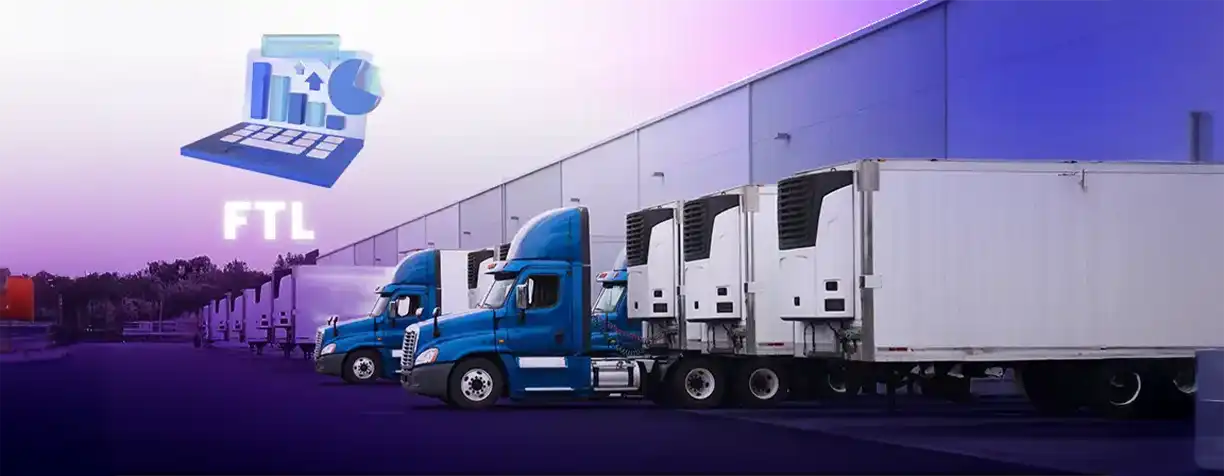Shipping goods is vital for companies aiming to maximize efficiency and reduce costs. Understanding FTL shipping meaning is vital to streamline logistics and demand fulfillment. FTL, or Full Truck Load shipping, involves using an entire truck for a single shipment, making it ideal for businesses with large volumes of goods. In this blog, we will explore the implications of FTL shipping for your business, covering related concepts that can enhance your logistics strategy.
Table of Contents
What is FTL Shipping?

FTL shipping meaning refers to the practice of transporting goods in bulk via a dedicated truck. This method is often preferred when shipping quantities are significant, as it allows for direct routes without delays caused by additional pickups and drop-offs. For businesses dealing with large inventories, FTL shipping can lead to cost savings and greater control over the supply chain.
Advantages of FTL Shipping
The advantages of FTL shipping extend beyond just cost savings. Here are several key benefits that make this shipping method appealing:
- Cost-Efficiency: When you have enough cargo to fill a truck, FTL shipping meaning often proves to be cheaper than LTL (Less Than Truck Load) shipping. It allows businesses to avoid the costs associated with multiple pickups and deliveries that LTL shipping in Canada incurs.
- Speed: FTL shipping offers faster delivery times since it does not make multiple stops along the route. For businesses interested in the fastest shipping in Canada, FTL is a suitable option.
- Reduced Risk of Damage: Fewer handling points mean less risk of damage to goods during transportation. This aspect of FTL shipping meaning is crucial for maintaining product integrity, particularly for fragile or sensitive items.
- Greater Flexibility: FTL shipping meaning allows for customized transportation solutions tailored to specific business needs. The entirety of the truck’s space can often be optimized for a single freight type, decreasing clutter and simplifying loading and unloading processes.
FTL vs LTL: A Closer Look
When evaluating shipping options, it’s important to consider FTL vs LTL, as both methods serve different business needs. Understanding these differences is key to choosing the right logistics solution.
- FTL Shipping: Typically used for shipments that can fill an entire truck (often over 10,000 pounds), providing direct routes and faster delivery times.
- LTL Shipping: Designed for smaller shipments that do not fill a truck, allowing multiple shippers to share transportation costs.
Here’s a summary comparison:
|
Shipping Type |
Minimum Load |
Cost |
Delivery Speed |
Key Benefit |
|
FTL |
Over 10,000 lbs |
Generally higher |
Faster |
Direct routes with less handling |
|
LTL |
Under 10,000 lbs |
Generally lower |
Slower |
Cost-effective for smaller loads |
The Role of 3PL Logistics in Canada

Many businesses leverage 3PL Canada to expand their shipping capabilities beyond traditional methods. Third-party logistics providers offer comprehensive services such as storage, inventory management, and fulfillment center in Canada. By partnering with a 3PL, your business can optimize shipping routes and leverage economies of scale, reinforcing the importance of understanding FTL shipping meaning in enhancing operational efficiency.
Utilizing FTL in 3PL Solutions
The integration of FTL shipping into 3PL solutions enables companies to improve their efficiency. For example, a logistics company might employ FTL shipping to improve the management of its fleet. With access to dedicated trucks, these providers can negotiate better trucking rates per km Canada, improving overall profit margins for businesses.
Impact of Technology on FTL Shipping

Technological advancements are significantly impacting FTL shipping operations across various sectors. Understanding FTL shipping meaning helps businesses leverage digital tools to track FTL shipments effectively while managing inventory with precision. For instance, incorporating transportation management systems (TMS) can enhance visibility throughout the logistics process.
Moreover, high-quality software applications allow companies to analyze logistics data, identify trends, and make data-driven decisions regarding their shipping methods. This capability is essential when considering the FTL meaning, especially in a fast-paced business environment where leveraging a 3PL warehouse in Canada can further enhance supply chain efficiency.
Case Study: Real-World Success of FTL Shipping
To illustrate the effectiveness of FTL shipping, consider the case of a medium-sized retail company that transitioned to using an FTL platform for its seasonal inventory. By consolidating shipments through the FTL platform, they achieved:
- 30% Increase in Sales: During peak months, faster delivery times and improved stock availability resulted in a significant sales increase.
- 20% Cost Reduction: Through bulk shipping, the company saved on transportation costs compared to individual LTL shipments.
This real-world example demonstrates how understanding FTL shipping meaning can directly impact a business’s bottom line and operational efficiency.
Additional Trends in Canadian Shipping
As consumer demands evolve, businesses must stay informed about new trends in logistics. Options like flat rate shipping in Canada provide straightforward cost structures, making it easier for companies to budget for transportation.
Another emerging trend is same-day delivery in Canada. With the rise of e-commerce, customers expect quick delivery options like two-day shipping, driving businesses to enhance their logistics strategies. The integration of courier services in Canada also plays a vital role in meeting these demands. Adopting FTL shipping can be crucial in ensuring timely deliveries, given its speed and efficiency.
Exploring Alternative Shipping Methods
In addition to traditional FTL shipping, businesses are increasingly exploring methods like transloading in Canada and cross-docking services in Canada. Transloading allows goods to be transferred between different transportation modes, optimizing logistics and reducing costs. Cross-docking minimizes storage time by unloading products from incoming shipments and directly loading them onto outbound trucks, which can be particularly useful when managing perishable goods.
The Importance of FTL in Freight Forwarding
Freight forwarding is another important concept associated with FTL shipping. Freight Forwarding Services help businesses manage international shipping by organizing logistics and ensuring compliance with regulations. Understanding the FTL trucking meaning allows freight forwarders to optimize shipping routes effectively, significantly enhancing cargo delivery reliability.
Conclusion
In summary, understanding the FTL shipping meaning is essential for optimizing your logistics and shipping strategies. For businesses with substantial shipment demands, FTL full truck load offers an efficient solution. Assessing your logistics needs and contrasting FTL with alternatives like LTL enables you to select the most beneficial option, ultimately enhancing your operational efficiency.
Embrace digital tools in the logistics industry to boost efficiency, and consider partnering with 3PL providers to streamline your FTL full truck load processes.





